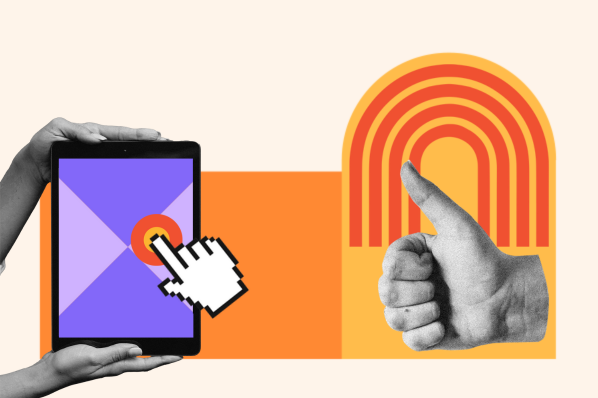So, I started working with the product team, and a product marketer was brought on board. Together, we overhauled the design and layout of the product interface with minimal changes to functionality. Over the course of six months, conversion rate best practices such as a customer success chat function and an in-product tour were introduced. From there, in-app sign-ups steadily increased. So did other UX metrics like time-to-action, time in product, churn rate, and more.
But what does it take to get digital UX design right? It’s all about understanding the UX principles that take a product experience from dull to delightful.
Table of Contents
- What is digital UX design?
- 7 Digital UX Principles
- Sites That Meet Their Digital UX Goals
- Tips for Getting It Right
What is digital UX design?
Digital User Experience (UX) design is the process of incorporating usability, accessibility, and graphic design into the structure and design of a digital product, app, or website. The goal of digital UX design is to improve the ease and enjoyment of users while they interact with your product, and this feeds into wider business goals related to reputation, revenue, and customer retention.
Digital UX design incorporates a wide breadth of roles and responsibilities. To get it right, you need the work of multiple teams and expertise.
For an app, you need to involve product designers, engineering, customer success, and marketing. A website needs the practiced hand of both front and back-end developers, a copywriter to craft the messaging, and marketing ops that know how to test and analyze interactions to maximize conversions.
All of this work culminates in a product that looks good, works quickly, and makes actions as simple as possible for users to complete. The result? Websites and products that users willingly and enthusiastically return to again and again, which is always good news for the bottom line.
7 Digital UX Principles to Master
UX impacts the performance of a website, from basic engagement metrics right down to company revenue. The XM Customer Experience (CX) Trends Report 2023 found that 88% of users are less likely to return to a website after a bad experience.
Not every team member who touches a website or app needs an in-depth understanding of every UX design principle available. An engineer or developer doesn’t need to be a stellar copywriter.
Similarly, a marketer doesn’t need to know the nitty-gritty details of how the back end of your software is coded. But everyone should understand the role they play from a UX perspective, and UX designers need a full grasp of all the principles at play.

1. User-Centric Design
When I say “user-centric design” to a client, everyone nods along in agreement. Everyone agrees that it’s important, but articulating what it actually means can be a challenge.
User-centric design means the look and functionality of a digital product meet the end user’s needs, keeps their preferences in mind, and aligns with their behaviors to make the UX as seamless as possible.
This principle requires some practical data gathering and continual website or product optimizations. Common tactics for measuring user-centric design (and understanding what you need to tweak) can include user satisfaction surveys, usability tests, and tracking specific engagement metrics over the long term.
This data gathering can range from high-level metrics gathered by a third-party tool (e.g., Google Analytics for websites) to detailed customer surveys launched on a quarterly or semi-annual basis.
Ultimately, this measurement is only worth it when put into practice. That’s because the goal of user-centric design is ultimately to make it better to use, so you can lower churn rates, increase repeat visits to a website, and improve conversions and online sales
2. Simplicity and Clarity
When it comes to UX design, simple and clear design is always preferable to clutter and complex processes. This feeds into how your site or app looks, but also how people can use it to perform actions. Users shouldn’t have to work hard or use their brains too much to use your site effectively.
Intuitive navigation and a clean layout are critical. In fact, navigation is one of the most important elements I’ll take a look at when working with a client.
Another exercise I like to perform is asking my clients, “What are some of the core processes I should be able to complete?”
They might tell me answers like “making an online purchase” if it’s an e-commerce website, for example. So, I’ll go to their site or app and try to complete that action, noting down how many steps it takes me, how long it takes, and if I run into any confusing steps along the way.
When it comes to a website or app, it can be hard when you’re so close to the design to take a step back and see if it truly embodies simplicity and clarity. Running tests or surveys like this can help uncover confusing UX elements you didn’t know were hampering your users.
Of course, you can always go the data measurement route here, too. Metrics like time to complete specific tasks, user error rates, and NPS scores all help to paint a UX picture.
3. Consistency
There should be a high level of consistency across all the visual elements of your digital product. This includes basic branding like color palettes and fonts, but it goes further than that too. The terminology should be the same, for example, and your users shouldn’t feel like they’ve accidentally navigated to an entirely different product when they move from one section to another.
But one common consistency challenge I come across regularly is a disconnect between multiple digital products. For example, does your website UX transition seamlessly into a consistent product experience when a user signs up? Is your brand recognizable no matter what page or screen a user lands on?
This often happens in SaaS when product and marketing don’t work in lockstep together.
Marketing takes the brand in one direction on the website, while the product team is doing something totally different when designing the app. Branding, copy, messaging, design—it all works together to provide the consistency that reinforces brand recognition and positive UX.
Measuring consistency is a little more abstract than other digital UX design principles. However, indicators like user error rates, navigation efficiency (heat maps are great for taking a look at this), and brand recognition metrics can help you understand if consistency is playing a role in your UX.
4. Responsiveness and Flexibility
If your website only works well on desktop and not mobile (or vice versa), its responsiveness and flexibility need to be looked at. Users are no longer accessing digital products from one place — your app needs to work seamlessly from one device to another.
Working with engineers is essential here, and so is testing. I use BrowserStack to test the functionality and responsiveness of websites across a wide range of screen sizes and browsers to make sure I don’t run into any issues.
If I do, it’s time to work closely with the developers to make sure responsiveness is built into the entire website and that we’re catering to as many browser preferences as possible.
5. Visual Hierarchy and Readability
Part of excellent digital UX design is the layout. A good layout goes beyond giving plenty of whitespace and making sure everything is well organized on the page. It’s about guiding users down screens and through navigation in a way that is logical and natural.
Visual hierarchy is a core component, and it’s one of the reasons I start with the homepage when taking a look at a client’s website. From the page hero right down to the site footer, the page should clearly communicate with the user, while giving them a natural progression from one section to the next and inserting calls-to-action and connections to other areas of the site in a way that makes sense.
Everything from the size and design of headings and graphics to the copy contributes to visual hierarchy and readability. When it’s done right, you can easily guide users to resources, actions, and conversions.
To measure whether your visual hierarchy and readability are working, you can take a look at heatmaps and screen recordings of users with tools like Hotjar. I use it to look out for users scrolling erratically or “rage clicking” to understand whether website pages flow naturally for users or leave them confused and frustrated.
6. Feedback and Interaction
Even when a digital product is clear and simple to use, you need to let users know that they’ve successfully completed what they’re trying to achieve (or not). Feedback and interaction make your website or app responsive to users’ actions. Not only does it keep them engaged, but it reduces confusion and provides a more user-friendly experience.
A lot of the time, I’ll notice that product designers have implemented error reporting pretty well. Red text or error messages clearly indicate to a user that they’ve taken the wrong path to execute an action. But I often notice that success messages take a back seat, even though I consider them to be just as important.
Aside from actual success messages (e.g., “Congratulations! Your account is now live”), there are lots of more subtle design elements you can use to incorporate feedback and interaction into your UX. This can mean small animations on button clicks or progress bars.
Also known as “micro-interactions,” these elements all contribute to an interactive and positive user experience, both psychologically and in how they help to guide users around the product.
7. Load Time and Performance
One thing is for certain: It doesn’t matter how good your website looks if it doesn’t perform well. There is an abundance of statistics showing that speed and performance are absolutely pivotal to good UX, and they can have a huge impact on attracting and keeping users on your site or app.
Load time and performance are aspects of UX that I commonly look at for technical SEO audits. Search engines like Google actively use site performance in their ranking criteria, and poor load times can mean that, even when organic visitors do get to the site, they’re far less likely to engage and convert.
Free tools like PageSpeed Insights and Google Lighthouse give you fast insight into load time and performance, along with specific test results that can be passed on to developers for improvement. For apps and software, tools like Apache JMeter help developers run performance and stress tests to reduce downtime and enhance user experience.
Depending on whether you’re testing a website or software application, success measurement can include things like page load times, bounce rates/engagement rates, server response time, and more.
Sites That Meet Their Digital UX Goals
Airbnb

By its very nature, with thousands of properties available in a given country or location, Airbnb ’s website has a lot going on. However, it still manages to provide a pretty clean interface and excellent navigation options for users to narrow down their searches.
One of the biggest things I think Airbnb gets right is the seamless experience between the desktop site and the mobile app. From integrating a user’s existing profile once they download the app to the ability to find everything in an intuitive way, Airbnb manages to provide the same extensive functionality on mobile without compromising on good UX.
Trello

Project management can get complicated, and there are lots of tools that have tried to provide project management software that keeps workflows simple regardless of how complex a project gets. But few do it better than Trello.
The Trello app combines the now familiar board interface with extensive customization options so users can get started immediately and create the experience they want. The clean board design keeps hierarchy and readability at the forefront of the user experience, so even new users who get invited to an existing board can get up and running quickly.
TED
Content-heavy websites can find it particularly challenging to build and maintain good digital UX, especially when it covers a wide range of topics and niches.

TED makes an interesting choice by keeping a chronological list of new videos on the homepage. But it balances this with easy-to-select topics and tracks above and a navigation bar that makes it easy to take action whether you want to watch, attend, or participate.
It’s also a very high-performance site, considering the huge amount of video content available, and both page and video load times are fast and efficient.
Tips for Getting It Right

Continuously gather feedback, test, and implement.
No matter how well you know UX design principles, it’s also essential to get to know your users. Lots of factors can affect whether specific UX elements will work from one product to another. For example, if you’ve got dominant competition in a relatively niche software space, users’ existing experience with a platform can influence their expectations for how your product will look and operate.
So, gathering data, analyzing it, and rigorously implementing worthwhile feedback is essential. A UX designer’s work is never done, and making this a continuous feedback loop ensures your product is always doing more to delight users.
Stay up-to-date on UX trends.
What was considered good UX design yesterday does not necessarily stand up to scrutiny today. Just take a look at how most websites looked 5-10 years ago, and you’ll see how quickly things can change.
From functionality to graphic design best practices, good UX designers stay on top of what’s happening in the industry and adjust their strategies accordingly. I stay subscribed to UX Design Weekly and Designer Hangout to see what the latest research has to say.
Don’t shy away from qualitative feedback.
A/B testing and NPS surveys are essential tool in any UX designer’s belt, but don’t be afraid to dig into the qualitative feedback you receive from users.
There’s a lot of insights to be gained from reading through product reviews or written feedback in a survey. The best product designers love nothing more than sitting down with customers to chat about what they like about a piece of software and what they’d love to see in the future.
Qualitative feedback provides context to data-backed decisions or quantitative assessment methods. It can help you pinpoint more closely what’s leading to any negative aspects of your UX or what’s really hurting conversion rates.
Getting Started
With new technologies like generative AI on the scene, the world is changing rapidly. And in an innovative sector like tech, things never stay the same for long.
But no matter how the landscape itself changes, the principles of digital UX design are human-oriented and user-centric. So, if you keep on top of trends while remaining steadfast in your UX design principles, you’re sure to continue building products and websites that both delight and guide your users with a positive experience.
User Experience
.png?width=112&height=112&name=Image%20Hackathon%20%E2%80%93%20Square%20(10).png)
.png)


![How to become a UX designer, a step-by-step guide [expert tips]](https://53.fs1.hubspotusercontent-na1.net/hubfs/53/become-a-ux-designer-1-20240731-321437.webp)


![How to Add a Parallax Scrolling Effect to Your Website [Examples]](https://53.fs1.hubspotusercontent-na1.net/hubfs/53/scroll-Aug-11-2023-05-24-08-8793-PM.png)

![20 UX Design Examples Hand-Picked by Experts [With Analysis]](https://53.fs1.hubspotusercontent-na1.net/hubfs/53/ux-design-examples-1-20250404-8425368.webp)
